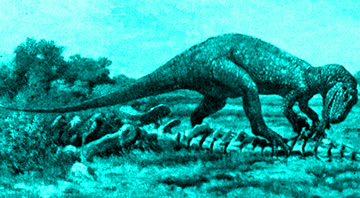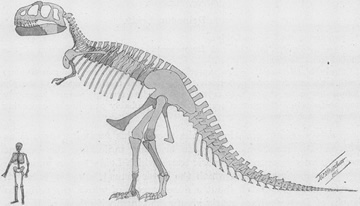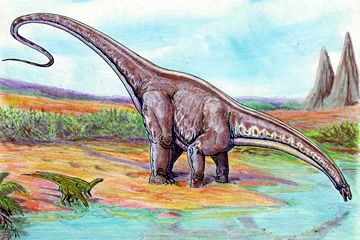Dinosaurs were masters of the Earth when the environment was perfectly adpated for cold-blooded creatures.
Continental climates were generally more tropical than now. Reptile species multiplied widely, and around 200 million years ago the Earth was perfect for the dinosaurs.
The first primitive dinosaurs tended to stand up and run on their hind legs and were flesh-eaters that preyed on other reptiles.
Dinosaurs later evolved into plant-eaters and some of these reverted to four-footed locomotion. Others developed in an astonishing direction - toward flight.
 From the early flesh-eaters sprang such giant predators as Allosaurus, predominant around 150 million years ago. Allosaurus walked upright and measured nearly 40 feet from the tip of its snout to the tip of its tail. Its head was about three feet long, with massive jaws armed with saber-like teeth.
From the early flesh-eaters sprang such giant predators as Allosaurus, predominant around 150 million years ago. Allosaurus walked upright and measured nearly 40 feet from the tip of its snout to the tip of its tail. Its head was about three feet long, with massive jaws armed with saber-like teeth.
 Allosaurus was succeeded by Tyrannosaurus, a bigger killer that remains the largest flesh-eater ever to stalk the Earth. Tyrannosaurus' skull and jaws were twice as massive as those of Allosaurus, and its overall length was about 50 feet. It carried its head some 20 feet above the ground.
Allosaurus was succeeded by Tyrannosaurus, a bigger killer that remains the largest flesh-eater ever to stalk the Earth. Tyrannosaurus' skull and jaws were twice as massive as those of Allosaurus, and its overall length was about 50 feet. It carried its head some 20 feet above the ground.
Certainly, among such formidable carnivores, daily survival required extraordinary defensive measures on the part of plant-eaters. Thus Stegosaurus' back bristled with a double file of bony plates; its lashing-tail was armed with spikes. Ankylosaurus' armored shell was edged with sharp spines that must have discouraged any prying. And Triceratops looked like a knight ready to joust with two long, lance-like horns projecting from a bony shield that protected the back of its neck.
 Diplodocus and Apatosaurus (Brontosaurus as it used to be known) belonged to a group whose members attained lengths of nearly 90 feet and weights exceeding 50 tons.
Diplodocus and Apatosaurus (Brontosaurus as it used to be known) belonged to a group whose members attained lengths of nearly 90 feet and weights exceeding 50 tons.
They waded in swamps, often with only their tiny heads exposed, the buoyant effect of the water helping to support their bulk.
Pteranodon - its wingspan of 25 feet making it one of the biggest flying creature in the annals of this planet - is thought to have used its foot and wing claws to climb trees. Then, spreading its wing membranes, it swooped down in a silent glide to take unsuspecting prey.
No one is sure why the dinosaurs became extinct. Some 70 million years ago they began dying off; after a few million more years, dinosaur evidence vanishes totally from the fossil record. Some scientists speculate that certain species of newly evolved mammals caused their demise by eating their eggs; others suggest they perished in an epidemic.
Many authorities in the 1970's pointed to the onset of colder climates, which limited the dinosaurs' food supplies. In winter today, reptiles survive by burrowing into the soil to hibernate, which the giant reptiles could hardly do. Why colder temperatures? Continental drifting was carrying major land masses generally poleward, and new mountain ranges cut off warm air from the sea.
The most commonly accepted theory today is that a cataclysmic impact event on Earth, i.e. a large asteroid crashed into the Earth and caused a reaction like a super massive atomic bomb, wiping out a large portion of life forms alive during the 'Cretaceous-Tertiary extinction event' around 65 million years ago.
Remember though that the dinosaurs were ruling the Earth many thousands of times longer than humans have existed, millions of years before our ancestors travelled the plains of Africa.